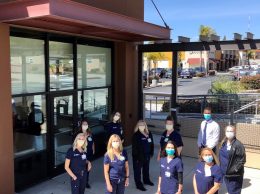
Firefighters battle the Sherpa fire in Santa Barbara County.
Southern California’s persistent drought is making life tougher and tougher for the region’s firefighters. And the worst may be ahead of us.
As Staff Writer Marissa Nall reports in this week’s edition of the Business Times, the Sherpa fire took a large bite out of agricultural production in Refugio Canyon and surrounding areas.
Meanwhile, fire danger is actually rising thanks to rains that caused more grasses and small brush to grow but did not replenish groundwater supplies.
That will put more and more pressure on firefighters as we progress deeper into this year’s fire season.
The region’s agricultural industry has plenty at stake when it comes to the rising fire threat. Complex irrigation systems are made of plastic and melt easily, costs go up exponentially for cattle ranchers when feed literally goes up in smoke and the relocation of animals to safe zones like the Earl Warren Showgrounds or Santa Maria Fairpark is at best a temporary solution.
California does have more resources to bring to bear than during the depths of the recession, and the availability of air drops to mitigate fire damage is impressive. But it’s also an expensive proposition; the Sherpa fire alone cost taxpayers more than $18 million in direct firefighting costs.
This year’s budget includes $77 million and 454 temporary help positions for the year ending June 30, 2017, to address heightened fire conditions. An additional $6 million will be used to replace mobile equipment and more than $20 million will be spent on helicopters including $10.4 million for contract help and $12 million to buy a new chopper for California Department of Forestry and Fire Protection use, according to a release from the office of Assemblymember Das Williams.
It’s also up to all of us to provide support to local firefighters in Ventura, Santa Barbara and San Luis Obispo counties. The Santa Barbara Firefighters Alliance has already put out a call for funds to replace equipment used up fighting the Sherpa fire. And we need to replenish reserve funds at the Red Cross, which sheltered evacuated families during the fire.
San Luis Obispo County needs better rules
A court ruling that required olive oil producer Pasolivo to assess the environmental impact of its proposed expansion is going to force a rewriting of the rules for agribusiness expansion in San Luis Obispo County.
The ruling, which came amid expansion moves by one of the region’s pioneering companies and a lawsuit by wary residents, puts a new layer of regulation in front of would-be entrepreneurs.
But it’s up to the San Luis Obispo County Board of Supervisors to craft new rules that enable small businesses in the agricultural sector to develop and grow — without the fear of having to go to court every time they want to add a new process or expand a facility.
The future of agriculture in our region depends on the ability of farmers to increase the production of food. They are going to find it harder and harder to grow crops without being able to process them into marketable products.
We’d encourage the Board of Supervisors to move quickly to create news rules for on-land development that will head off another Pasolivo fiasco.






 Print
Print Email
Email

















